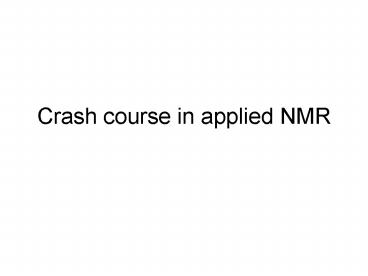Crash course in applied NMR - PowerPoint PPT Presentation
Crash course in applied NMR
Choice of solvents, deuterium locking. Tube handling and cleaning. Tube labeling ... Indicate when machine is in use. Return everything as you found it. No ... – PowerPoint PPT presentation
Title: Crash course in applied NMR
1
Crash course in applied NMR
2
Practical aspects
- Sample preparation
- No solids!
- Balanced tubes, proper filling
- Choice of solvents, deuterium locking
- Tube handling and cleaning
- Tube labeling
- There is an on-line manual for our NMR!
3
Instrument etiquette
- Indicate when machine is in use
- Return everything as you found it
- No metals around NMR
- Leave door closed (and AC in control)
- Consider sample concentration, no endless runs
during day time
4
Basic considerations
- CV vs. FT principles
- Locking, shimming
- Definitions pulse, pulse delay
- Signal to noise ratio
- Proton vs. carbon
- Sample spinning
- Spinning side bands
- TMS outdated chloroform signal at 7.26
5
A second look at interpretation
- Kinetic effects DMF has two methyl peaks!
- Methylcyclohexane (below)
- same shift for axial/equ. methyl
6
Exchangeable protons
- Types amines, alcohols, carboxylic acids
- Pooling of different types
- Peak broadening, see below
- Shaking out with D2O
- Absence of spin splitting
4-hydroxybenzoic acid
7
Second order considerations
- Conditions for 2nd order
- Leaning peaks, uninterpretable spectra
benzofuran
8
Description of spin systems
- J values
- 1, 2, and 3 bond coupling
- Long range coupling
- Spin systems A-B, A-X etc.
9
Aromatic patterns phenyl
benzoic acid
toluene
10
Aromatic patterns disubstitution
3-nitobenzoic acid
4-hydroxybenzoic acid, AAXX
11
Ortho, multiple subst.
12
Lanthanide shift reagents
Addition of paramagnetic compounds such as
Eu(fod)3
13
Suggested review
- McMurry, discussion of homotopic, heterotopic,
enantiotopic, and diastereotopic relationships - Hoffman Ch. 11
PowerShow.com is a leading presentation sharing website. It has millions of presentations already uploaded and available with 1,000s more being uploaded by its users every day. Whatever your area of interest, here you’ll be able to find and view presentations you’ll love and possibly download. And, best of all, it is completely free and easy to use.
You might even have a presentation you’d like to share with others. If so, just upload it to PowerShow.com. We’ll convert it to an HTML5 slideshow that includes all the media types you’ve already added: audio, video, music, pictures, animations and transition effects. Then you can share it with your target audience as well as PowerShow.com’s millions of monthly visitors. And, again, it’s all free.
About the Developers
PowerShow.com is brought to you by CrystalGraphics, the award-winning developer and market-leading publisher of rich-media enhancement products for presentations. Our product offerings include millions of PowerPoint templates, diagrams, animated 3D characters and more.































